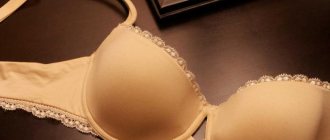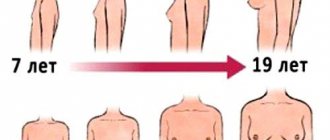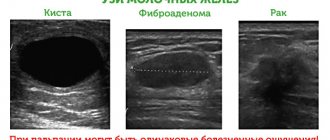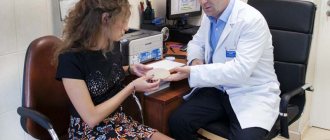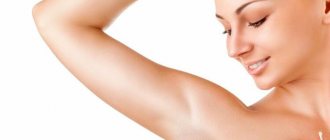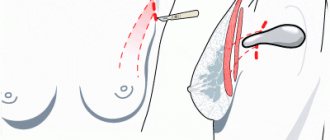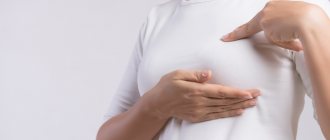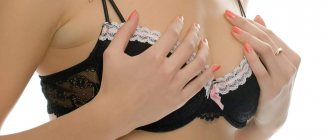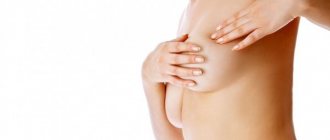Mastopathic chest pain
The characteristic breast pain is accompanied by swelling, hardness and is often associated with another disease - endometriosis. Pain from mastopathy usually goes away with the onset of menstruation, and then returns almost immediately. The cause of mastopathy is usually hormonal disorders. The changes usually appear between the ages of 30 and 40 and gradually disappear after menopause. To confirm them, it is necessary to do an ultrasound, measure the level of hormones in the blood, and sometimes a mammogram. Hormonal drugs are used in treatment.
Diseases and pathologies
Uterine fibroids, which can increase breast volume, increasing nipple sensitivity. The disease affects hormonal levels and metabolism.
- Polycystic ovary disease, which can significantly increase estrogen production. If you ignore the disease, the sensitivity is felt more and more, constantly progressing.
- Candidiasis is a fungal disease accompanied by itching, pain, swelling of the nipples, and the formation of cracks and blisters on them. The infection can enter the baby's body through breast milk.
- The endometrium of the uterus - the nipple and areola are the most affected.
- Lactostasis, which develops due to stagnation of milk in the breast.
- It is recommended to discuss any changes or unpleasant sensations that cause suspicion with a specialist - a mammologist. Do not delay contacting a doctor if pain is additionally accompanied and intensified by the following symptoms:
Itching
- Skin redness
- Inverted nipple
- Changes in breast shape
- Breast tenderness may indicate:
Inflammatory processes in the body
- Infectious diseases (mastitis)
- Malignant neoplasms (oncology)
- Mastopathy
- Tubular papilloma or other tumors
- Recovery, recovery from illness, and reduction of breast sensitivity is much more difficult than it seems at first glance. Therefore, it is better to avoid such problems. To do this you need:
Breast pain caused by bra
Diseases can have very mundane causes, for example, injuries caused by strong seat belt tension in a car when braking. Breast pain also affects women who wear ill-fitting bras (for example, with cups that are too small). When shopping for a bra, be sure to measure the circumference under your bust and around your chest at nipple level. There should be 1-2cm of sag in the cups because breasts swell and change shape over the course of a month, and under the bust the bra should fit snugly but not cut into the body. Be careful with underwire bras as they can put too much pressure on your breasts and cause pain.
What you need to know before surgery
- During the first 2-3 weeks after mammoplasty, 80% of women experience numbness in the mammary glands. This is due to swelling, which puts pressure on the nerve fibers.
- The body's reaction to the introduction of an endoprosthesis can be expressed both in loss of sensitivity and in its aggravation.
- The percentage of women who have lost breast sensation after breast augmentation during primary intervention is low.
- Much more often, the brightness of sensations remains at the same level or increases due to the pressure of the implant.
- If there is a change in sensitivity, you should contact the operating doctor. Part of the skin may become numb due to the scar forming. Timely measures taken will save you from unnecessary problems.
- There are many ways to restore the previous erogenous activity of the site.
Neoplastic chest pain
Breast pain caused by cancer usually only appears when the tumor usually grows more than 1 centimeter, and the woman feels it during a breast self-exam. In such a situation, quick diagnosis is important. Therefore, you should definitely consult a doctor if you feel any changes in your breasts. In the vast majority of cases, the disease is curable. Surgery is required, and in the case of a malignant tumor, surgery and chemoradiotherapy. Every woman should remember about breast cancer prevention, which should include regular examinations, that is, from the age of 25, an ultrasound examination is required once a year, and after 50, a mammogram. Moreover, every month, after the end of menstruation, a woman should perform a breast self-examination. If she does them regularly, she will be able to detect any alarming changes. In the case of breast cancer, genetics are also important - women who have had or have mothers, grandmothers or aunts in the family who have suffered from this disease in the past should be regularly examined. It is very important to check whether any women in your immediate family have suffered from breast cancer. BRCA1 and BRCA2 genetic tests should then be performed to confirm or rule out mutations in the genes responsible for the formation of not only breast cancer, but also ovarian cancer.
Sexuality of the breast
COVID-19✓ Safe
The mammary glands themselves do not belong to the reproductive system, but they play an important role in terms of sexual arousal, the logical result of which is procreation. They say that no man can resist the gaze of a naked woman. Breasts are a special area of the female body that symbolizes attractiveness, sexuality, femininity for men, and has a special erotic effect. Meanwhile, the direct purpose of the female breast is lactation!
When did breasts become an object of passion? Even in the ancient world, our primitive ancestors depicted their female deities with several breasts - it was believed that the more breasts a deity had, the richer the tribe would be, there would be plenty of food, and therefore life. In the era of antiquity, Venus was considered the ideal of female beauty, whose high-set, elastic, very small, but very attractive breasts became the standard of female breasts for a long time. Women's breasts became a truly sexual object in the Rococo era, when corsets turned into real works of art, decorated with embroidery and precious stones, and the breasts themselves in these corsets rose so high that they were ready to literally burst out. The chest was decorated with flies - artificial moles made of velvet or silk, which gave the chest a seductive piquancy.
As civilization developed, a woman with lush half-naked or bare breasts began to be actively used to advertise a variety of products - especially those that are very difficult to advertise and whose consumers are men. The directors of the commercials accurately guessed the mood of the male audience - the contemplation of an attractive female breast invariably fixes attention on the product, which forms its memorization and ultimately increases sales.
Why did lush breasts become a symbol of sexuality? Some men believe that the larger a woman's breast size, the more passionate and temperamental she is. In fact, there is no reliable data on the connection between the size of a woman’s breasts and sexuality. It is also erroneous to believe that women with zero breasts are unable to achieve orgasm. Different women have completely different breast sensitivity - while some can feel only weak impulses with fairly strong manual stimulation, others are able to experience an orgasm even from weak caresses. Moreover, the sensitivity of a woman’s breasts does not depend on the shape of the breast, nor on the color or size of the nipple or areola. The opinion that there are women with constantly erect nipples who are in a state of sexual arousal is erroneous. Normally, a woman’s nipple is at rest; in women who have given birth, the areola is light brown to dark brown in color; in women who have not given birth, it is pinkish, and the nipple is flat. And only active manual or oral stimulation causes it to “awaken”, rise above the surface of the areola, become hard and acquire a red color.
A woman perceives caressing the nipple and peripapillary space with the help of her tongue and lips almost as oral caresses of the clitoris, which occurs thanks to the nervous ligament of the mammary glands and the clitoris. By and large, only caressing the breasts can bring a woman to orgasm. Indeed, when the mammary glands are stimulated, the nipples send a signal through the pleasure center of the cerebral cortex to the genitals, causing blood to flow more strongly to the labia. The reverse reaction is the same: caressing the genitals, oral or manual stimulation of the clitoris causes the nipples to swell and the breasts to enlarge.
Unfortunately, the same mechanism does not work with breasts as with an erection: regardless of the initial size of the penis, during an erection both small and large penises increase due to the flow of blood into the cavernous bodies at the same time. That is why flat-chested ladies or women with very modest sizes may have a complex about the fact that they cannot adequately show their partner the full extent of their arousal. Because of this, they decide to do all sorts of tricks, enlarging or reducing (very rarely!) their breasts.
Currently, there are a huge number of various methods for breast enlargement using any available and even inaccessible methods. Unfortunately, very often many women fall for the bait of ordinary charlatans, paying a lot of money for a completely natural dream - to be beautiful. The only truly effective way to enlarge breasts at the moment is plastic surgery. The operation involves placing an implant - a special anatomically shaped bag filled with saline or silicone gel - into the cavity of the breast tissue. There are several different techniques - under the pectoral muscle, between the wall and the pectoral muscle, in 2 planes, etc. In each specific case, the doctor chooses the placement method, based directly on the specific situation.
The implant gives the breast not only a beautiful shape due to its special anatomical shape - semicircular, spherical, spherical, but also by enlarging the breast by at least 1 size (depending on the size of the implant). Any mammoplasty - surgery on breast tissue - is necessarily accompanied by a lift - mastopexy, as a result of which a woman gets the opportunity not only to enlarge her breasts, but also to tighten them.
A woman can undergo breast augmentation only after 18 years of age, when the mammary gland is almost fully formed. Breast augmentation surgery is a very serious procedure that requires special preparation. Preoperatively, it is often necessary to stop taking anti-clotting medications such as acetylsalicylic acid (aspirin), a standard ingredient in many painkillers. You should be sure to tell your surgeon about all the medications you are taking.
Before mammoplasty, a woman must undergo a comprehensive examination, take a number of necessary tests, undergo an ultrasound of the mammary glands, mammography, and receive a consultation with a mammologist. The specialists of the MEDHELP clinic will be happy to help you undergo this examination, warn you about possible complications, monitor your condition in the postoperative period and give the necessary recommendations for breast care during the rehabilitation period. You can always make an appointment with a mammologist, who will analyze your condition and advise you on further actions. You will definitely need our help in the postoperative period, and we will be happy to do everything to make this difficult time pass easily, quickly and unnoticed for you.
A course of rehabilitation therapy - developed by the scientific department of our clinic - will help you get in shape much faster and easier. The fact is that your body will need some time to adapt to its new state, and therefore rehabilitation therapy will come in handy.
In the clinic, in the rehabilitation therapy of patients after mammoplasty, special therapeutic antihomotoxicological regimens developed by the scientific department of our clinic are used. The naturopathic agents used have anti-inflammatory, antiviral, antitoxic, regenerating, anti-exudate, analgesic, and tissue microcirculation-improving effects, which makes it possible to eliminate any infectious and inflammatory processes, for example, in case of possible implant rejection.
The drugs used do not contain chemically synthesized components, which means they are non-toxic to the woman’s body, do not accumulate in the intercellular fluid, and are excreted without residue.
Specialists from our partner, the Institute of Plastic Surgery on Tsvetnoy Boulevard, based on clinical data from patients for 2007-2010. It was noticed that in patients who underwent rehabilitation therapy at the MEDHELP clinic after mammoplasty, the percentage of complications after operations due to reasons independent of the surgeon is half as much as in other clinics in general - 0.5%! Are you still thinking about where to undergo mammoplasty and rehabilitation? We already know! We are waiting for your calls!
Telephone
Accurate signs of pregnancy:
- The hCG pregnancy test is the most accurate sign of pregnancy.
- An ultrasound of the fetus at 7-12 weeks of pregnancy will give an accurate guarantee of the presence of pregnancy.
- The fetal heartbeat can be heard from the 12th week of pregnancy. The normal fetal heart rate is 120 – 160 beats per minute.
- Feeling the fetus is available in late pregnancy. Obstetricians can use it to determine the position of the fetus in the womb.
- Fetal movement . As a rule, it begins at 20 weeks of pregnancy.
If you see many of the first signs of pregnancy described, consult your doctor to accurately determine your situation. We hope you become a mother soon! Health to you and your baby!
1. Cyclic pain of the mammary glands
Many women experience breast tenderness and pain
- a problem that is medically called
mastalgia
. The pain may come and go according to the menstrual cycle or be non-cyclical and appear unexpectedly.
Cyclic breast pain
– The most common type of chest pain. This pain is caused by normal monthly hormonal changes in women. As a rule, both mammary glands begin to hurt at the same time. Patients describe their symptoms as heaviness and tenderness in the chest, which can radiate to the armpits and arms. The sensations usually intensify before menstruation and become easier after the end of the cycle. Young women are more likely to suffer from cyclical chest pain. During menopause, the discomfort disappears on its own.
A must read! Help with treatment and hospitalization!
